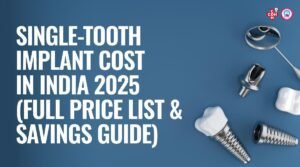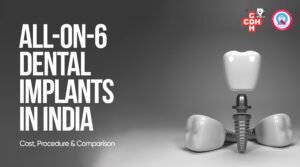Dental Hygienists remove tartar and plaque from your teeth. They cater to combating cavities and other gum ailments. They also offer preventive treatments like fluoride and fixatives. Dental hygienists work with dentists to help you achieve oral health objectives and maintain a healthy smile. In today’s blog, we will understand who a dental hygienist is and what they do in depth.
Before beginning, we would like to introduce City Dental Hospital- Rajkot. We’re a leading dental clinic in Rajkot and specialise in all gum and teeth diseases. We also provide implants, cosmetic, and painless dental treatments at affordable rates. Our team comprises the best and the most experienced senior dentists and dental hygienists who know how to empathise with their patients.
We know that a bright smile plays a major role in displaying confidence. At our top dental hospital in Gujarat, we offer personal attention, flexible timings, accurate treatment explanations, and healthy relationships with patients. Furthermore, we strictly cater to following rigorous hygiene protocols.
Continue reading the blog to learn about some common dental terms!
Overview of Dental Hygienists
- Most people haven’t heard about the term ‘dental hygienists’ even today. There’s a difference between dentists and dental hygienists.
- Dental Hygienists are licensed oral healthcare experts who provide teeth cleanings, oral hygiene suggestions, and protective oral healthcare treatment.
- They are also referred to as “Oral Hygienists”.
- They have a particular scope of dental treatments they prescribe to their patients.
- A major operation they perform is periodontal therapy, which comprises periodontal charting, periodontal debridement (scaling and root planing), prophylaxis (obstructing disease) or periodontal nurturing procedures for patients with periodontal ailments.
- Using therapeutic or remedial methods helps patients control oral gum diseases while offering customised treatment plans that highlight the importance of behavioural changes.
- Thus, it wouldn’t be wrong to say that dentists wouldn’t be able to work without any fuss if dental hygienists were not there!
Courses Required to Become a Dental Hygienist
- Depending on where you reside and the course you choose, it takes around 2-4 years to become a trained dental hygienist.
- If you want to become one, you can take up a bachelor’s or an associate’s degree in dental hygiene from a reputed college.
- The training comprises generic education merits, dental hygiene courses, and hands-on clinical experience.
- Exact requirements are variable depending on each state.
- Note that you must have a license to start practising legally no matter where you are and what state you belong.
Patient Assessment and Oral Health Education
First of all, dental hygienists perform an assessment or evaluation of their patients to understand the root cause of their issues. The examination comprises three parts:
Patient History
Note personal profile information, present and earlier oral health or treatment history, health measures, and specific dental history.
Perform a Full-Fledged Clinical Assessment
This includes examining the head and neck as well as oral cavity dominions, oral cancer examinations, trauma evaluation, and TMJ examination. Further assessment measures include radiography, a holistic periodontal evaluation, and a complete hard tissue evaluation.
Risk Assessment
It is a quantitative and qualitative insight gathered from the examination process to identify any risks to oral and general health. In simple words, the hygienist assesses if any risk is there and whether the risk is high, low or moderate.
Patient Education
The next steps include explaining the importance of maintaining dental hygiene to the patient. They take ample time to discuss and record all the aspects of the patient’s generic and oral health. They explain the correct methods of brushing, flossing, and tailored treatment plants to the patients. Furthermore, they offer dietary recommendations to the patients to prevent cavities or other tooth ailments.
Dental Cleanings and Periodontal Therapy
Depending on the frequency of the risk (low, moderate, or high) assessed after evaluation, it’s time to perform the treatment on the patient. Here is a series of dental cleanings or periodontal therapy performed on the patient:
Scaling and Root Planing
It is a non-intrusive method of decreasing gum infection by deeply cleaning the periodontal pocket. Most patients require scaling and root planing only to reverse the symptoms of common gum ailments like gingivitis. However, if the problem persists, they may need additional therapeutic measures.
Cleaning
During the visits, the hygienist would polish, clean, and floss your teeth to help you get rid of tartar, plaque, or hardened bacteria. When amalgamated with domestic oral care and regular flossing, routine dental cleaning helps achieve healthy oral health and a beautiful smile!
Dental X-rays and Treatment Planning
- Next comes the oral ailment imaging or performing dental X-rays, also known as Radiographs.
- The dental hygienist, along with the dentist, performs X-rays on the patient to discover what hidden ailments are present which can’t be seen with the naked eye.
- The possible issues could be hardened cavities, jawbone infections, secondary teeth, or affected wisdom teeth.
- Different types of dental x-rays serve distinct purposes.
- A Periapical Film or PA shows the whole tooth, comprising the roots and the surrounding bone.
- A Lat Ceph X-ray provides a side view of the face and is used when planning tailored orthodontic treatment.
- Finally, a Cone Beam CT, which is applied when dentists are assessing the jaw and teeth is especially helpful when examining for dental implants. A Cone Beam CT is a modern approach that provides three-dimensional imaging (like a standard CT scan – but with lower radiation).
Infection Control and Sterilization
Preventing the spread of gum diseases or infections is very crucial in ensuring optimal the patient’s and health care provider’s safety. These strategies include
- Sterilising the equipment every time after operating on a patient.
- Using personal protective equipment (PPE) like gloves and masks.
- Heat-based sterilisation and high-level chemical disinfection of instruments.
- Safe injection practices like using disposable ones and sharps handling.
- Disinfecting clinical surfaces, dental water quality maintenance, and special precautions for combating airborne ailments like COVID-19.

Conclusion
To conclude, a dental hygienist is different from a dentist, though they may seem the same. They perform together on a patient to clean their teeth, hardened cavities, plaque, bacteria, tartar, and other serious infections. The methods include scaling and root therapy, performing X-rays, and developing tailored treatment plans.
Infection control measures are also entertained by dental hygienists, like sterilising needles, maintaining treatment water quality, and using disposable injections. Dental Hygienists play a crucial role in ensuring optimal oral health and a healthy smile for many patients.
Need an appointment with one? City Dental Hospital- Rajkot is here at your service! Book a safe appointment now and get your first dental consultation at your pace!













